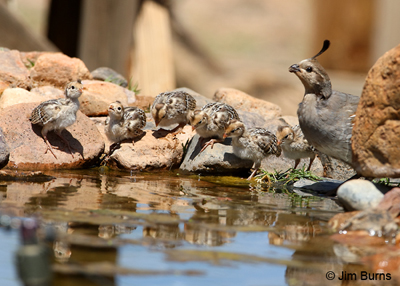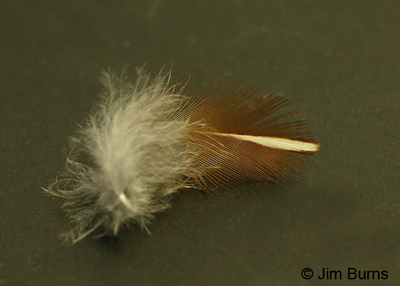
Gambel’s favorite environment is brushy canyons and washes, particularly those with mesquite near water. Chicks will readily gobble up insects, but the adult Gambel’s diet is almost exclusively vegetarian, and mesquite bosques provide both cover and a staple of that diet in the seedpods of the trees. Families coalesce into feeding coveys numbering up to thirty or forty birds in late summer through late winter, pairing off and leaving the covey in spring to nest.
Eggs, up to a dozen, hatch in about three weeks, and the young, like that of all quail species, are precocial—they are already well developed right out of the egg, which allows them to leave the nest within a day after hatching. When you see a long line of young walking through the desert between two adults, that’s dad in the lead, mom bringing up the rear. The chicks are long-legged, downy, fuzzball replicas of their parents, unable to fly for about ten days but immediately capable of amazingly quick runs whenever trouble threatens. Parents lead the babies to food, but the young feed themselves. Wet years with good food supplies may see two broods.
Whereas Montezuma Quail numbers are closely tied to our summer monsoon rains,
Gambel’s numbers correlate closely to winter precipitation, October through March.
Here’s your stat of the week—in a high production, wet year, the Arizona Department of Game and Fish guesstimates there are 20 million(!) Gambel’s Quail in the state, and they know this, of course, because Gambel’s Quail are good to eat.
If you’re an anti-hunting birder, so be it, but not all of us are, and here’s one good excuse for those who aren’t. Leaving aside moral and ethical issues for the strictly economic, quail hunters must purchase a hunting license which costs about $40. In an average year the average number of hunters in the field is around 60,000. If you’re doing the math along with me, quail, principally Gambel’s, are paying not only their own way but also the cost of a lot of ancillary environmental expenses such as research, habitat preservation and restoration, and wildlands maintenance.
As I type these lines, I hear the Gambel’s in our front olive tree waking, stirring, and beginning to call. If I go outside and peer up through the leaves to the brightening sky, so well do they blend in I cannot discern any quail shapes, but the quailsound and intermittent small showers of twigs and flower buds me assure me our tenants are still with us and doing well.
